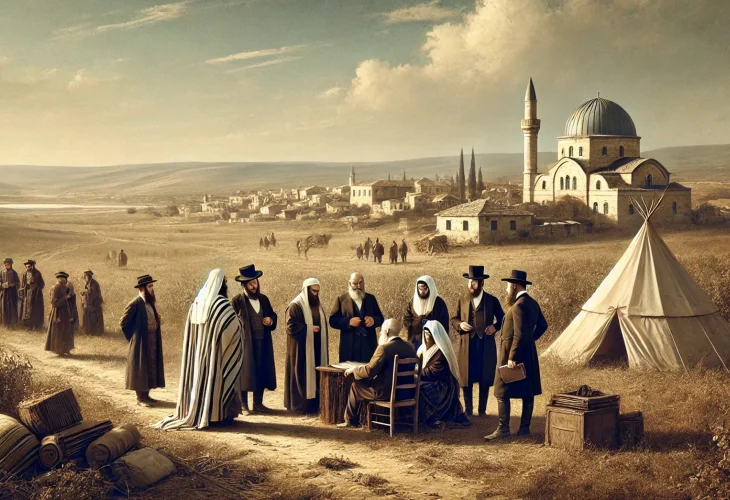The Hidden History of Hadera: From Swamps to City
An unprecedented land deal, graced by Russian Jewish investment, brought to life a Torah-based community in the challenging landscapes of 19th-century Palestine.

For many outside the northern Sharon area, visiting Hadera might seem as appealing as stopping by "the city next to the Hadera interchange." With its first hotel built only in 2017, a lack of a major university, and no famous shopping centers, Hadera still boasts a population of over 100,000 and has existed for 134 years.
Founded officially in 1891, the vision for Hadera began nearly a decade prior. Triggered by Russian pogroms, Chovevei Zion (Lovers of Zion) sought safe havens for Jews wishing to leave Russia. Led by Rabbi Moshe Mordechai Epstein, head of Slabodka Yeshiva in Lithuania, this initiative birthed Hadera, which started as a traditional Jewish community under his guidance.
Like many other towns in the region, Hadera was established by devout Jews driven by their faith. Representatives of Chovevei Zion arrived in a desolate Palestine and met with the legendary land purchaser Joshua Hankin. Hankin informed them of Effendi Salim Khoury's extensive plots for sale.
Salim Khoury, a Christian Arab, a former interpreter at the French Consulate, recognized Palestine's land as gold and acquired vast tracts, especially around Haifa. He resided in the luxurious "Khoury House," now known as "Khoury Street." After his death in 1925, his son, Nasrallah Khoury, quickly drove the estate into bankruptcy, leading to its acquisition and transformation into "Tower of the Prophets" by Zachariah Drukar.
Khoury, wise to the Jews' determination, aimed to profit immensely by selling them a vast swathe of land ignored by locals for centuries. "Al Khazira," the "Greeneries," lay south of Caesarea, a sandy expanse between modern Hadera and Herzliya's edges. Mountains of the Shomron directed rainwaters eastward in a complex network of streams and rivulets, their combined neglect silting their outlets to the sea, creating giant, deadly swamps—heaven for wildlife but hellish for humans. The "Al Khazira" swamps, notorious for their stagnant breeding grounds, were lethal, even for errant goats that sank into the mud or succumbed to malaria from mosquito bites.
But the Jews... they eagerly paid dearly for a slice of Palestinian land; Effendi Khoury offered thirty thousand dunams, a scale unseen since the Crusades! And the price? Excellent. It enticed the finest Jewish funds from Russia. A new Jewish city, adhering to Torah principles, was to be established by Russian immigrants. Rabbi Moshe Mordechai Epstein himself traveled to Palestine to see this acquisition he championed and blessed the new settlers' ventures. Yet, even he could not fathom the malignant hinderance those swamps would pose.
The settlers strategized from an ancient Ottoman building known as the "Khan," where caravans once rested, planning to drain the swamps. But before acting, the swamps struck them first. As recounted by one of the early settlers, Zehava Shapira, in a 1966 interview: "After a day and night of camel travel from Hadera to Ramla, our room was prepared at the Khan. That evening, Khan residents kindled a bonfire and danced in the courtyard. Among them, a young, tireless dancer suddenly collapsed unconscious. Rushed to Dr. Yafe in Zikhron Ya'akov, he passed that same night." No one realized that a simple mosquito bite delivered the deadly malaria. Malaria drove fevers high until a person would collapse.
With grit, the settlers set to confront the swamps. Visionarily standing atop hills, they delineated potential ditches to draw centuries-old sands and silt and release the swamp waters. Yet, who dared approach the mosquito-laden swamps?
Many tales surround their first attempt. Some sources claim settlers tied a rope around a dog, affixed a pipe to the rope, and placed the first pipe in the swamp, using a pump on the dry end to empty the area. Without tractors, hand-dug channels were their only solution. Malaria raged among settlers: from 514 residents, 214 succumbed. Effendi Khoury knew this "cursed land," while he counted his coins; the 1890 "Hatzvi" newspaper wrote: "Most inhabitants suffer from cruel fevers, seeking buyers for their homesteads in vain." Some left for other cities; others confined themselves to the ancient Khan.
In 1896, Baron Rothschild intervened to help Hadera’s settlers. He heard of eucalyptus trees in Australia, newly discovered a century ago, that grew tens of meters high and consumed vast amounts of water. Eucalyptus, akin to willows used during Sukkot, indeed drinks plenty. Hundreds were planted between and in the swamps. Yet, unknowingly, eucalyptus wouldn’t drain surface swamps—their roots probed deep for water. Persistence with channel digging cleared most of the land, prompting mosquitoes to depart due to shrinking food sources. Thus Hadera rose. The last surviving swamp can still be seen at Sharon Park Nature Reserve.
The colony flourished. A bid for constructing a grand synagogue was announced; Judith Stolzer, famed architect from Kaunas, won. Her unique design resulted in a magnificent synagogue. Next door, ten ancient Khan rooms converted into residences for yeshiva students, supported by settlement farmers.
As time passed, the founding elders died, and their offspring veered differently. By the 1960s, few kippa-wearing Jews remained in Hadera. The synagogue stood empty; rooms for scholars filled with farm tools turned into a museum.
In 1986, corresponding to 5746 in the Hebrew calendar, Rabbi Schach, of blessed memory, sent twelve youths from Bnei Brak to establish a yeshiva in synagogueless Hadera. Today, the city hosts numerous yeshivas, kollels, a thriving Orthodox community, nursery schools, day schools, and ample synagogues.

